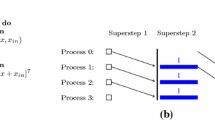Abstract
This paper presents a new parallel computing model, called H-BSP, which adds a hierarchical concept to the BSP(Bulk Synchronous Parallel) computing model. An H-BSP program consists of a number of BSP groups which are dynamically created at run time and executed in a hierarchical fashion. H-BSP allows algorithm designers to develop more efficient algorithms by utilizing processor locality in the program. Based on the distributed memory model, H-BSP provides a group-based programming paradigm and supports Divide & Conquer algorithms efficiently. This paper describes the structure of the H-BSP model, complexity analysis and some examples of H-BSP algorithm. Also presented is the performance characteristics of H-BSP algorithms based on the simulation analysis. Simulation results show that H-BSP takes advantages of processor locality and performs well in low bandwidth networks or in a constant-valence architecture such as 2-dimensional mesh. It is also proved that H-BSP can predict algorithm performance better than BSP, due to its locality-preserving nature.
Similar content being viewed by others
Reference
Todd Heywood and Sanjay Ranka. A practical hierarchical model of parallel computation. 1. The model. Journal of Parallel and Distributed Computing, 16:212-232, 1992.
W.F. McColl. General purpose parallel computing. In A. Gibbson and P. Spirakis, eds., Lectures on Parallel Computation, pp. 337-391. Cambridge University Press, Cambridge, UK, 1993.
D.B. Skillicorn. Architecture-independent parallel computation. IEEE Computer, 23:38-50, 1990.
D. Culler, R. Karp, D. Patternson, A. Sahay, K. Schauser, E. Santos, R. Subramonian, and T. von Eicken. LogP: Towards a realistic model of parallel computation. In Proceedings of the 4th ACM SIGPLAN Symposium on Principles and Practices of Parallel Programming, 1993, pp. 1-12.
Susanne E. Hambrusch and Ashfaq A. Khokhar. C 3: A parallel model for coarse grained machines. Technical report, Purdue University, January 1995.
Leslie G. Valiant. A bridging model for parallel computation. Communication of the ACM, 33:103-111, 1990.
Thomas Cheatham, Amr Fahmy, Dan C. Stefanescu, and Leslie G. Valiant. Bulk synchronous parallel computingŠa paradigm for transportable software. Technical report TR-36-94, Harvard University, December 1994.
Christoph Kebler and Helmut Seidl. Making FORK practical. In Workshop on Models of Parallel Computation, Universiteit Utrecht, January 1995.
Simon Knee. Program development and performance prediction on BSP machines using opal. Technical report PRG-TR-18-1994, Oxford University, August 1994.
W.F. McColl. BSP Programming. DIMACS Series in Discrete Mathematics and Theoretical Computer Science, May 1994.
B.A. Wagner. Hyperquicksort: A fast sorting algorithm for hypercubes. In Proceedings of the Second Conference on Hypercube Multiprocessors, 1987, pp. 292-299.
Todd Heywood and Sanjay Ranka. A practical hierarchical model of parallel computation: Binary tree and FFT algorithms. Journal of Parallel and Distributed Computing, 16:233-249, 1992.
Author information
Authors and Affiliations
Rights and permissions
About this article
Cite this article
Cha, H., Lee, D. H-BSP: A Hierarchical BSP Computation Model. The Journal of Supercomputing 18, 179–200 (2001). https://doi.org/10.1023/A:1008113017444
Issue Date:
DOI: https://doi.org/10.1023/A:1008113017444




